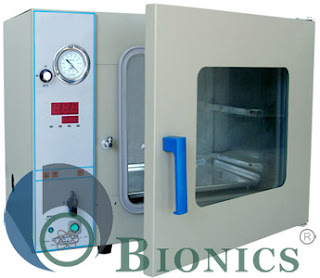Vacuum Oven Manufacturing in India: An Insight into Quality and Affordability
India's industrial landscape is witnessing a remarkable
evolution, with a surge in manufacturing capabilities across various sectors.
Among these, the vacuum
oven manufacturing sector has emerged as a significant player, catering
to diverse industries like pharmaceuticals, aerospace, electronics, and more.
As the demand for high-quality vacuum
ovens continues to rise, understanding the market dynamics, including
the vacuum
oven price in India, becomes crucial for businesses and professionals
alike. In this article, we will delve deeper into the
vacuum oven manufacturing scenario in India and shed light on the
pricing factors influencing this dynamic market.
The Rise of
Vacuum Oven Manufacturing in India
The
vacuum oven manufacturing industry in India has experienced substantial
growth over the years, driven by advancements in technology, increased
investments in research and development, and a growing demand for specialized
equipment across various industries like bionics scientific
Manufacturers in India have been quick to adapt to global standards, leveraging state-of-the-art technology and stringent quality control measures to produce vacuum ovens that meet international benchmarks. This commitment to excellence has positioned India as a reliable hub for vacuum oven manufacturing, attracting attention from both domestic and international markets.
Understanding
Vacuum Oven Price in India
When it comes to purchasing a vacuum
oven, understanding the pricing dynamics is essential to make informed
decisions. Several factors influence the vacuum
oven price in India, including:
1. Quality and
Features: High-quality vacuum ovens
equipped with advanced features such as precise temperature control, efficient
drying capabilities, and user-friendly
interfaces often come at a premium price.
These features enhance performance, durability, and overall user experience,
making them a preferred choice for industries prioritizing efficiency and
reliability.
2. Manufacturing Costs:
The cost of raw materials, labor, and manufacturing
processes significantly impacts the final price
of vacuum ovens. Manufacturers employing cost-effective production
methods without compromising on quality can offer competitive pricing, making
their products more accessible to a broader range of customers.
3. Brand Reputation:
Established brands with a proven track record of delivering quality products and excellent customer support may
command higher prices compared to lesser-known brands. However, investing in a
reputable brand often ensures reliability, durability, and comprehensive
after-sales services, offering better value for money in the long run.
4. Market Competition: The competitive landscape plays a pivotal role in determining the vacuum oven price in India. Manufacturers striving to gain a competitive edge may offer promotional discounts, bundle offers, or flexible pricing strategies to attract customers and expand their market share.
Choosing
the Right Vacuum Oven Manufacturer in India
With numerous manufacturers vying for attention in the Indian
market, choosing the right vacuum
oven manufacturer can be a daunting task. To make an informed decision,
consider the following:
1. Reputation and
Experience: Opt for manufacturers with a solid reputation and extensive
experience in the vacuum
oven manufacturing industry. A proven track record signifies
reliability, quality, and customer satisfaction.
2. Quality Assurance:
Ensure the manufacturer adheres to international quality standards and employs stringent
quality control measures throughout the manufacturing
process. This ensures that the vacuum ovens meet the required
specifications and deliver consistent performance.
3. Customer Support:
Evaluate the manufacturer's after-sales
services, including warranty coverage, maintenance support, and technical
assistance. Prompt and efficient customer support can make a significant
difference in addressing any issues or concerns that may arise post-purchase.
4. Value for Money: While price is an important consideration, focus on obtaining the best value for your investment. Compare the features, quality, and pricing offered by different manufacturers to find a vacuum oven that aligns with your requirements and budget.
Conclusion
The
vacuum oven manufacturing industry in India is thriving, with
manufacturers continuously striving to innovate and deliver high-quality
products tailored to meet the diverse needs of various industries.
Understanding the vacuum
oven price in India and the factors influencing it can help businesses
and professionals make informed decisions and invest wisely in equipment
that offers optimal performance, reliability, and value for money.
In conclusion, India's
vacuum oven manufacturing sector presents a plethora of opportunities for
businesses seeking quality and affordability. By partnering with reputable
manufacturers and focusing on quality and innovation, businesses can enhance
their operational efficiency, productivity, and competitiveness in the global
market, driving growth and success in their respective industries.

Comments
Post a Comment